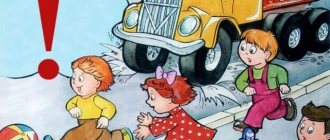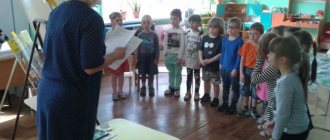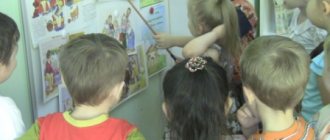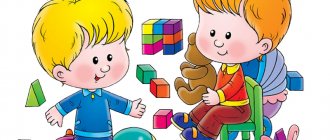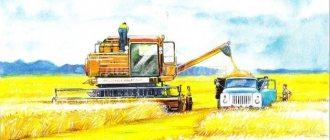The teacher must compose a story-description of the toy in advance, highlighting the main sentences (usually three of them) that will help children describe the toy, talk about something specific, for example, first about how beautiful the doll is. (Our doll is very beautiful. She has... (big blue eyes, rosy cheeks)
.) Then - how elegant she is, and later about how the doll is a musical toy.
In the first storytelling sessions, short (3-4 minute long) dramatization games are offered. The set of techniques used in the game is varied, and at the same time, they are all designed to help children pay attention to the features of the toy’s appearance and pronounce a sentence that reflects these features.
For example, a duckling is hiding, and the children call him: “Yellow fluffy Quack, come out!”, or tell the hare: “We see, we see your long white ears.” They guess what color the character's eyes are, agree or refute his opinion about his own appearance, think about why the hare is sad and what should be done to help him.
In this case, the example of the teacher’s descriptive story, which completes the dramatization game and contains a “played out set of actions and words,” is perceived by children with joy, as something pleasant and familiar. The end of the story involves emotional communication between children and the toy: hugging a duckling, giving a sad hare a carrot, etc.
Due to the fact that in the fifth year of life, children have not formed such a component of voluntary memory and attention as retaining a motive, a sequence of actions, the teacher should help preschoolers compose a story, prompting them with the main sentence: “Our doll is very beautiful,” the teacher reminds. - She has…"
Children on an intuitive (unconscious) level learn to tell stories, adhering to a certain plan. And this is one of the main tasks of teaching storytelling.
In order to teach children to use a variety of vocabulary when telling their own stories, a special lesson on writing descriptive stories is held at the end of October. Children are offered two toys that differ in appearance (two Cheburashkas, two cats). The teacher talks about one toy, and the children, following the example, talk about another toy. Then the children and the teacher exchange toys.
At the end of November, a control lesson is held to find out whether the children understand that they should talk about the toy in a certain sequence.
Teaching children to tell a story according to plan and trying to give their own name to what is depicted are the main tasks in working with a plot picture. (The ability to examine a picture was taught to children in previous age groups.)
When preparing for a lesson on teaching storytelling from a picture, the teacher must also first compose a short story (10-13 sentences), highlighting in it the main linking phrases that direct children to pay closer attention to a specific object. For example: “The cat has kittens. They have grown up and can take care of themselves. It is so? (Children talk about kittens. Everyone is listened to.) A big beautiful cat admires kittens, doesn’t it? Tell us about her... Kittens, I think, are happy at home. And what do you think?.."
Having formulated a question, the teacher listens to the children, clarifies something, is surprised at something, and, having received sufficient information, summarizes what was said or assigns one of the children to do it.
Over the course of the year, children review and learn to write narrative stories based on story paintings in 4–5 lessons.
The lesson plans use the following pictures: “Dog with puppies” (by S. Veretennikova; November), “What a snowman!” (author V. Gerbova; December), “Tanya is not afraid of frost” (author O.I. Solovyova; January), “In the clearing” (author V. Gerbova; February), “Dandelions” (author V. Gerbova) or “ Cat with kittens" (author S. Veretennikova; March: control lesson).
An effective means of developing children's creativity and activating their speech is the work of creating and describing pictures made up of handout pictures on a matrix field. First, this task should be offered to a subgroup of children (4-5 people), using a flannelgraph (drawing sheet). The teacher, having laid out 3-4 pictures along the edges of the field, informs the children that in front of them is a circus arena (a forest clearing, an African reserve, etc.). “It’s up to you to decide what kind of performance is on at the circus,” says the teacher, laying out handout pictures in front of the children. At the same time, the teacher introduces a rule: the child (children) can use only 3-4 pictures and be sure to talk about the content of the created plot.
Text of the book “Classes on speech development in the middle group of kindergarten. Lesson Plans"
March
Lesson 1. Getting ready to celebrate spring and International Women's Day
Target.
Introduce children to A. Pleshcheev’s poem “Spring”. Practice your ability to congratulate women on the holiday.
Progress of the lesson
The teacher reminds the children that March is the first month of spring and no matter what the weather is outside, spring is coming.
The teacher reads the poem “Spring” by A. Pleshcheev (abbreviated):
The snow is already melting, streams are running, Spring is blowing through the window... The nightingales will soon whistle, And the forest will be covered with leaves. The azure of the sky is pure, the sun has become warmer and brighter, the time of evil blizzards and storms has passed again for a long time.
“Well, can we find signs of spring here, in our hometown (village)?” - asks the teacher.
The teacher completes the child(ren)’s answer with lines of the poem: “The snow is already melting, the streams are running... The sun has become warmer and brighter,” etc.
Then he reads the poem again.
The teacher reminds the children that International Women's Day is celebrated in March, the first month of spring. On this day, it is customary to congratulate mothers, grandmothers, and sisters and give them flowers, souvenirs, and gifts.
“What words are customary to say when congratulating someone on a holiday? - the teacher is interested. “How do you reach out to moms when you give them flowers or handmade crafts?”
Children say congratulations suggested by adults, for example: “Dear mother (grandmother, godmother). Congratulations on the spring holiday. I wish you health and happiness."
The teacher explains that you can wish a loved one “good health”, “good friends”, “all prosperity”, “an obedient son (daughter)”, etc.
Next, all children say the first two words of congratulations, “I wish you...”, and compose a wish for mom themselves (3-4 answers).
At the end of the lesson, the teacher can read to the children I. Kosyakov’s poem “She’s All”, which the children met in the second junior group.[9]
Lesson 2. Sound culture of speech: sounds shch - ch
Target.
To train children in correctly pronouncing the sound
u
and differentiating the sounds
u – h
.
Progress of the lesson
“My Tongue has learned to sing a new song,” the teacher begins the lesson. - Listen: “Sh-sh-sh.” What did you hear? Try to sing it, but don’t forget to hold the tip of your tongue behind your upper teeth and stretch your mouth (pull the tips of your lips towards your ears, like this).”
Children pronounce the sound all together, then only girls (only boys, only Sasha, Olya, etc., 4-5 children).
"Sound sch"
similar to the familiar sound
h
. These sounds are loved when children confuse them. But you can't fool us, can you? Shall we check? Then quietly but clearly repeat after me:
Asch-ach-ach - ach-ach-ach, Cha-cha-cha - sch-sch-cha, Ech-ch-ch-ch-ch.
Now a very difficult task. You have to guess what sound is heard in the words of this sentence: “Girls and boys jump like balls.”
And what sound is hidden in the words of these poetic lines (Samuel Marshak “About everything in the world”):
I clean the puppy with a brush, I tickle his sides.
And now a very, very difficult task. u in the word
and clap your hands:
I’ll put on a raincoat... I’ll catch a pike... I’m looking for the missing puppy... I’ll treat the hedgehog with milk
(the teacher pronounces the words with the same pause).
Can you count how many words with the sound u?
in the proverb (asks you to show the answer on your fingers): “Shchi and porridge are our food.”
If cabbage soup is cooked for lunch, it is advisable to remind the children of the proverb: “Where the cabbage soup is, look for us.”
If there is time left, you should introduce preschoolers to the reverse poems of I. Selvinsky “What is right?”
Buckwheat in the oven, felt boots on the heap? (Is this correct?)
Buckwheat In felt boots, Stove On the heap?
(Correct? Wrong?)
Felt boots In the oven, Buckwheat on the heap?
(What's wrong?)
Felt boots in buckwheat, Zavalinka in the oven?
(What's mixed up?)
Note.
Outside of class, having reminded the children of the poem “What’s Right?”, you can invite them to compose their own flip-flops, focusing on the following initial lines: “There’s porridge on the hill, Masha in the crib.”
Lesson 3. Russian fairy tales (mini-quiz). Reading the fairy tale “The Cockerel and the Bean Seed”
Target.
Help children remember the names and contents of fairy tales they already know. Introduce the fairy tale “The Cockerel and the Bean Seed.”
Progress of the lesson
“One very famous Russian folk tale is called “The Cockerel and the Bean Seed,” the teacher begins the lesson. -Have you ever seen beans? If you haven't seen it, watch it after class. The bean seed is not small at all. And why am I telling you about this, you will understand after listening to the fairy tale.”
The teacher reads the work.
“I think this is a good fairy tale,” the teacher continues the lesson. - And what do you think?"
The teacher listens to the children's answers. He agrees that all the heroes helped the chicken get butter: the blacksmith, the owner, the cow, the hostess.
The teacher draws the children’s attention to how many gentle-sounding words there are in the fairy tale: not grain, but... (grain)
, not a housewife, but...
(hostess)
, not a cow, but...
(cow)
, and also a darling, not a throat, but...
(neck)
, not butter, but...
(butter)
.
“We got acquainted with a new fairy tale. What other Russian folk tales can you name?” - asks the teacher.
Then he shows the covers (drawings) of fairy tales that the children were introduced to this year. Using different techniques, he asks the children to name the fairy tale and remember how it ends. The teacher suggests learning the fairy tale by:
– her initial phrase: “Once upon a time in a hut there was a cat, a rooster and a little man... (“Zhikharka”);
- excerpt: “Green milk, you guys are friendly, come fight with me, beat up the arrogant berry!” (“The War of Mushrooms and Berries”, arranged by V. Dahl);
- song (rhymed lines): “The stone is heavy, the stone is pulling to the bottom, the silken grass has entangled its legs...” (“Sister Alyonushka and Brother Ivanushka”). And so on.
Lesson 4. Compiling stories based on the picture
Target.
Check whether children can adhere to a certain sequence when composing a story based on a picture; did they understand what it meant to title a picture?
Progress of the lesson
“In class, we learned how to compose stories based on pictures,” the teacher begins the lesson. “And today I want to test what you have learned.”
The teacher offers the children the painting “Dandelions”[10]. (If this painting is not available, you can use the painting “Cat with Kittens”, by S. Veretennikova.)
The teacher reminds the children that the story will turn out to be interesting, without repetition, if we consider the picture in a certain sequence: first talk about the teacher, then about the children, and later about what surrounds the characters.
The teacher listens to the child’s story (optional) and asks him to name the picture. If necessary, it helps to start the story: “The teacher and the children are walking...”
Then he listens to two more stories. Summarizes, explains what children have already learned.
At the end of the lesson, he invites the children to run and blow on dandelions, practicing long exhalation (an imaginary situation).
April
Lesson 1. Reading to children the fairy tale by D. Mamin-Sibiryak “The Tale about Komar Komarovich - Long Nose and about Hairy Misha - Short Tail”
Target.
Introduce children to the author's literary fairy tale. Help them understand why the author calls the mosquito so respectfully.
Preliminary work.
The day before, children should read “The Tale of the Brave Hare - Long Ears, Slanting Eyes, Short Tail” by D. Mamin-Sibiryak (from the repertoire for children 3–4 years old); repeat the unusual title of the fairy tale - the characteristics of the hare.
Progress of the lesson
The teacher reads to the children an excerpt from “The Tale of the Brave Hare - Long ears, slanting eyes, a short tail” by D. Mamin-Sibiryak: “The young hares giggled, covering their faces with their front paws, the kind old hare women laughed, even the old hares who had been in the paws smiled from the fox and tasted the teeth of the wolf..."
The teacher asks the children who made the hares laugh, in what fairy tale this happened. It reminds you who wrote the fairy tale and suggests listening to another work by the author.
The teacher reads “The Tale about Komar Komarovich - Long Nose and about Hairy Misha - Short Tail”, gives the children the opportunity to exchange impressions.
“That’s how unlucky Misha the bear turned out to be - Short Tail,” the teacher notes. “I thought I was great and strong and no one could defeat him.” However, the clubfooted and shaggy one was mistaken. The mosquitoes outwitted him and drove him out of the swamp. But Mamin-Sibiryak admires the mosquito. And the mosquito is brave and persistent! What does he call him respectfully?..” (Komar Komarovich.)
If there is time left, the teacher reads 1-2 excerpts from the fairy tale at the request (choice) of the children.
Lesson 2. Sound culture of speech: sounds l, l
Target.
Exercise children in clearly pronouncing the sound
l
(in sound combinations, words, phrasal speech).
Improve phonemic awareness - learn to identify words with the sounds l, l
.
Progress of the lesson
“My Tongue has learned to sing a new song,” the teacher begins the lesson. - He overheard this song from the turkey. The turkey ran around the yard, got angry and muttered: “Bl-bl-bl, bl-bl-bl.” What was the turkey muttering? To make a turkey song, you need to puff out your cheeks and make your tongue run fast and fast: “Bl-bl-bl.” Try...
Now let your tongue bask in the spring sun, make it wide, lift it up and hide it behind your upper teeth.
Smile widely and sing: “L-l-l.” Rest and try to sing again: “L-l-l.”
Let's listen to how Katya turns out this song. (Names 3-4 children.)
The turkey, the teacher continues, has an angry song. When you sing it, your lips hit each other. Check if this is true.
But at the bell the song is sung easily, tenderly: “Li-li-li” (sound and
should sound as quiet as possible). Help me, bells. (The song is sung first by the girls, then by the boys, and then by several children individually.)
Now we will sing different songs. Some are like the song of a turkey, others like the song of a bell:
La-la-la - la-la-la, Ly-ly-ly - li-li-li, Lu-lu-lu - lu-lu-lu, Ol-ol-ol - yal-yal-yal."
The teacher shows the children a toy puppy and asks them to describe it. (Small, white, shaggy, with a ribbon and medal on his neck...)
The teacher invites the children to listen carefully to the song (“Summer”, from Macedonian poetry retold by L. Yakhnin), in which there are many words with the sounds l, l
.
He reads it twice:
Summer
walked
across ,
Summer sewed and embroidered
.
Meadow
with flowers,
Forest with leaves
.
Then the teacher reads the first two lines, and the children try to name words with the sounds l, l
.
The teacher asks what it means: “Summer sewed and embroidered.”
Next he conducts the “Don’t make a mistake” exercise. Children clap their hands if they hear a word with the sounds l.
or
l
:
onion... garlic... lemon... fox... beauty... lily of the valley... white... forest... pilot... frog... frog
.
If you have time, you can please the children by giving them a cheerful poem by V. Orlov “From the Bazaar”:
-Where are you coming from, frog frog? - Home from the market, dear friend! -What did you buy? – A little bit of everything: I bought KVApustu, KVAsol, AND KVAartoshka.
Lesson 3. Teaching storytelling: working with a matrix picture and handout pictures
Target.
Teach children to create a picture and talk about its content, develop creative thinking.
Progress of the lesson
The teacher reminds the children that they already know how, using a flannelgraph and album matrix pictures, to create their own stories on a given topic.
“Let's check what we have already learned,” says the teacher. “We will create pictures on the theme “Forest Clearing.”
The teacher places 2-3 pictures on a flannelgraph (trees, bushes, berries, etc.) and explains: “This is a forest clearing. There are no animals, birds, berries or mushrooms on it yet. But they will appear with your help. In the clearing you will meet a bear, an elk... (lists animals); the berries will ripen (lists), mushrooms will grow, mushroom pickers will appear..."
The teacher shows what picture can be made. Having laid out pictures (no more than 5), he composes a story: “At night, a fungus grew under a tree - boletus. A squirrel saw him and wanted to pick a mushroom. But something alarmed her. A girl with a basket appeared in the clearing. The girl saw a squirrel. The squirrel noticed the girl. What do you think happened next? The squirrel ran away, and the girl also left. There was a fungus left under the bush - boletus. Why did you stay?
Next, the teacher invites the child to compose a story based on the picture (optional). Evaluates his story, notes the most interesting points.
Then the teacher calls two more children.
Concluding the lesson, the teacher says that the children have learned to independently create interesting paintings on the theme “Forest Clearing.”
Note.
If the group has “Learning to Speak” albums, work in class can be organized differently. A child creates a picture on a flannelgraph, and two children (or four, if there are two albums) on a landscape sheet. First, the child working at the flannelograph is listened to, then the children composing the pictures on the spot (having agreed which of the two partners will tell the story).
Lesson 4. Memorizing poems
Target.
Help children remember and read one of the poems expressively.
Memorizing the poem by Yu. Kushak “Little Deer”
Progress of the lesson
The teacher reminds the children that many of them liked the not at all funny, but very, very touching poem by Yu. Kushak “The Little Deer”.
The teacher reads a poem and asks the children if they would agree to learn it. Having received the consent of the children, he rejoices and reads the poem again.
The teacher asks the children to answer the question:
The doe fell ill and never got up? (4–5 confirmations)
The answer-question form of communication allows children to quickly remember the beginning of the poem.
The teacher repeats these lines and adds the following two to them:
The fawn's mother passed away.
The teacher asks the preschoolers to read the quatrain quietly and so that it conveys sympathy for the orphaned child (4–5 answers).
“The child,” the teacher continues, “is trying with all his might to help the fawn:
I stroke him and feed him from my palm. I love him very, very much."
Children practice expressively reading these lines (4-5 individual answers).
The teacher reads the first two parts of the poem and adds the last:
And He gallops stubbornly after me everywhere. Let him think that I am his mother.
“So, the fawn stubbornly follows his friend,” explains the teacher, “even when the child, apparently, does not allow the baby to jump after him. Otherwise, where would the word stubbornly
».
The teacher reads the quatrain twice, but each time differently. In one case, it intonationally highlights the words behind me
, in the second - the word
stubbornly
. I wonder which of the recitation options the children liked best.
Next, children read these lines independently (3-5 repetitions). The teacher names the child whose improvisation seemed most successful to him.
The teacher reads the poem in full. Then he repeats it, and the children quietly, almost without a voice, read the poem along with him.
Next, the poem is read by 2-3 children, who quickly memorize the verses and convey them expressively.
Learning the Russian folk song “Grandfather wanted to cook fish soup”
Progress of the lesson
The teacher says that he intends to please the children by introducing them to the Russian folk song “Grandfather wanted to cook fish soup.”
The teacher reads the poem twice. Asks the children if this is really a good song and if they can prove it.
“It’s a sin not to learn this song. Any adult will be pleased if he hears it performed by you,” the teacher continues.
The teacher repeats the first four lines, and after a pause the children finish the names of the animals (2-3 repetitions), remembering the names of the cat and the rooster.
Grandfather wanted to cook fish soup, Grandfather went to catch ruffs, And behind grandfather was the cat Lavrenty, Behind the cat was the rooster Terenty.
The teacher reads the quatrain again and adds the following two lines to it:
They drag fishing rods along the street.
“Is it easy for a cat and a rooster to drag grandfather’s fishing rods? - asks the teacher. - It would be easy, then there’s another word, not the word drag
would be used in a song. The cat and the rooster drag fishing rods and sigh:
Grandfather can't bear it alone. We need to help the old one."
The teacher trains the children in expressive reading of the last lines, asking them to read them together: the child representing the cat reads the entire line, and the child representing the rooster, sighing, agrees with the cat: “I can’t bear it, I need help.” The exercise is repeated 4–5 times. Each time the performers change.
The teacher asks if there are fishermen among the children and what they know about ruffs. Then he explains: “This is a funny folk song, there is a lot of slyness in it. Even the fish that grandfather is going to catch to cook fish soup is bony and prickly. It’s difficult to clean, and the cat will suffer when he’s about to feast on the fish.”
The teacher repeats the song. Children read it together with the teacher, almost without a voice, but clearly articulating the words.
Note.
In the following days, the teacher reads the song with the active help of the children. Listens to a child who has expressed a desire to read the song on his own.
May
Lesson 1. Victory Day
Target.
Find out what children know about this great holiday. Help me remember and expressively read T. Belozerov’s poem “Victory Holiday”.
Preliminary work.
Contact parents of children with a request to tell preschoolers about relatives who participated in the Great Patriotic War.”
Progress of the lesson
“Many years ago, when your grandparents were still children, a long and terrible war ended,” the teacher begins the lesson. – Many cities and villages were destroyed. Many people died. Do you know anything about this?
The teacher listens to the children's answers and summarizes their stories.
“In the distant May days, the fighting ended and peace was signed. And since then, every Ninth of May, our country, our people celebrate Victory Day,” the teacher continues the lesson. – On the streets you will meet elderly people with orders and medals. Smile at them, congratulate them on their holiday, wish them health. Many songs and poems have been written about Victory Day. I will read one of them to you."
The teacher reads T. Belozerov’s poem “Victory Holiday”. He asks if you liked the poem. He reads the work a second time and invites the children to memorize it.
“Grandfathers and grandmothers will be grateful to you if you please them on Victory Day by reading this poem. And I will help you remember it.
May holiday Victory Day is celebrated by the whole country?
The teacher asks the children a question, asking them to reproduce the text with an affirmative intonation (choral and 3-4 individual answers).
The teacher repeats the beginning of the poem, adding two more lines to the first three lines:
Our grandfathers put on the Military Orders.
The teacher also reads these lines with a questioning intonation. First, all children answer questions, then 2-3 children individually.
The teacher reads the first five lines of the poem. He asks why the former soldiers put on their orders and where the road is taking them in the morning.
In the morning the road calls them to the solemn parade. And thoughtfully from the threshold the Grandmothers look after them.
The teacher reads the poem in full. Then he repeats it outside of class.
Lesson 2. Sound culture of speech: sounds r, r
Target.
Exercise children in clear and correct pronunciation of the sound
r
(in isolation, in pure phrases, in words).
Progress of the lesson
“I will introduce you to the most growling and rumbling sound,” the teacher begins the lesson. - This is the sound r
».
Asks children to pronounce this sound (r-r-r-r)
, repeat it, try to determine where the tip of the tongue is when pronouncing the sound
(behind the upper teeth)
and what happens to the tongue
(the stream of air makes the tongue tremble)
.
“Onomatopoeia and words that have the sound r
, a lot,” says the teacher and suggests saying some of them: kar-r-r, crack-crack, crack-crack, gru-gru, whoa; crayfish, river, chamomile, mitten, rubber, pink.
The teacher asks the children to help him read the tongue twister “Magpies” by S. Farhadi, which contains many words starting with kar-rr-r
.
The teacher reads the tongue twister, having agreed with the children that, at his sign, they will clearly pronounce kar-rr-r
, and he will name the word.
In the morning, Sitting on a green hillock, the magpies learn Tongue twisters: kar-r-r -toshka -tonka -eta -ace kar-r-r -niz -andash -amel -apuz.
Next, the teacher conducts the “Don’t make a mistake” exercise. Children clap their hands when they hear a word starting with the sound r.
:
rainbow... radio... repair... plane... rocket... early... late... baby... tough... child... drawing... applique
.
The teacher asks the children to guess whether there is a sound r
in the poem by S. Marshak “About everything in the world”:
Digs
the ground like
a gray mole
-
Ruins the garden
.
As soon as the children name 2-3 words, the teacher reads the poem again and names the words that the children did not name.
In conclusion, he asks the children to guess the riddle:
Without arms, without legs, And the door opens. (Wind)
Lesson 3. Saying goodbye to preparations
Target.
Pay attention to children who are leaving kindergarten and wish them a good journey.
Preliminary work.
Tell the kids that the children in the preparatory group will have a prom. They go to school.
Review graduates’ “diplomas” with your children and admire their photographs. Make the children want to give older children souvenirs made with their own hands (in kindergarten and at home).
